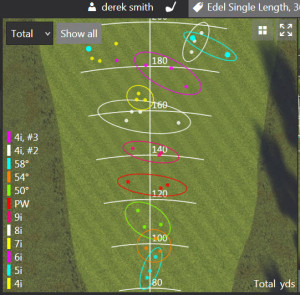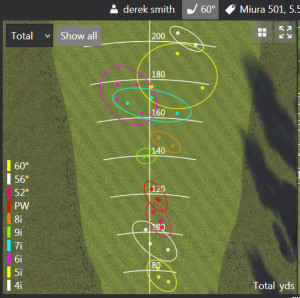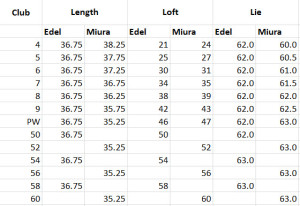
 Single length iron sets have gotten much more press since Bryson DeChambeau has been using them to win the NCAA Championship, U.S. Amateur Championship -2015, and Low Amateur at the 2016 Masters. Last week we published a blog about how we went about our build of single length irons with our master club builder. This blog post is about the initial TrackMan test results of the single length irons versus his traditional set. The key things we were looking for from a statistics standpoint are distances, distance gaps between irons and shot dispersion. The images above are the actual single length irons that were built by Derek, the TrackMan shot tests done with those single length irons and then the TrackMan tests done with Derek’s traditional set. Since this is the very first test, we knew there would be some tweaking of lofts, lies and even how we weighted the heads. As a fitter, I would expect a couple of things. First, distances may be shorter with the lower lofted clubs and longer with the higher lofted clubs primarily due to club length. Second, shot dispersion MAY be better with the single length irons because the swing plane is consistent from club to club as well as the lie angles.
Single length iron sets have gotten much more press since Bryson DeChambeau has been using them to win the NCAA Championship, U.S. Amateur Championship -2015, and Low Amateur at the 2016 Masters. Last week we published a blog about how we went about our build of single length irons with our master club builder. This blog post is about the initial TrackMan test results of the single length irons versus his traditional set. The key things we were looking for from a statistics standpoint are distances, distance gaps between irons and shot dispersion. The images above are the actual single length irons that were built by Derek, the TrackMan shot tests done with those single length irons and then the TrackMan tests done with Derek’s traditional set. Since this is the very first test, we knew there would be some tweaking of lofts, lies and even how we weighted the heads. As a fitter, I would expect a couple of things. First, distances may be shorter with the lower lofted clubs and longer with the higher lofted clubs primarily due to club length. Second, shot dispersion MAY be better with the single length irons because the swing plane is consistent from club to club as well as the lie angles.
How we Did the Test
 We tested the clubs indoors using TrackMan with the altitude setting at 1,000 ft. at 70 degrees. We used the Callaway Chrome Soft ball. We started with the Edel single length set and went from lowest loft to highest loft. We hit no more than 4 shots with each club and only took out a couple very nasty shots! We took a 10 minute break after the Edel irons and then moved into Derek’s current set of Miura CB-501’s. His current set is built with Rifle shafts built to a 5.0 flex. At the left are the static specs on the two test sets. First, notice the club length in the Edel single length irons is 36.75″, the length of Derek’s current 7 iron. The club lengths in Derek’s traditional set vary by 1/2″ from 4 iron to PW and then stay at 35.25″ in the 50, 54 and 58 degree wedges. This is the way we typically build wedges in our sets…all the same length. This sometimes creates heavier swing weights in the higher lofted wedge (54 degrees and above), especially with long hosels like on the Vokey and Miura wedges. In order to get the single length clubs to swing weight at D2, Derek had to add 18 grams to the 4 iron and drill out 36 grams of weight from the lobe wedge.
We tested the clubs indoors using TrackMan with the altitude setting at 1,000 ft. at 70 degrees. We used the Callaway Chrome Soft ball. We started with the Edel single length set and went from lowest loft to highest loft. We hit no more than 4 shots with each club and only took out a couple very nasty shots! We took a 10 minute break after the Edel irons and then moved into Derek’s current set of Miura CB-501’s. His current set is built with Rifle shafts built to a 5.0 flex. At the left are the static specs on the two test sets. First, notice the club length in the Edel single length irons is 36.75″, the length of Derek’s current 7 iron. The club lengths in Derek’s traditional set vary by 1/2″ from 4 iron to PW and then stay at 35.25″ in the 50, 54 and 58 degree wedges. This is the way we typically build wedges in our sets…all the same length. This sometimes creates heavier swing weights in the higher lofted wedge (54 degrees and above), especially with long hosels like on the Vokey and Miura wedges. In order to get the single length clubs to swing weight at D2, Derek had to add 18 grams to the 4 iron and drill out 36 grams of weight from the lobe wedge.
Test Data from TrackMan
Launch Angle
The first thing we noticed is that the 4 iron in the single length set was launching way too low. While not shown in these test results, we re-adjusted the positioning of the lead tape that was adding weight to the 4 iron to a spot lower on the back of the club head. This lowered the center of gravity and allowed Derek to get a higher ball flight. The resulting hits were 3 degrees higher and flew 202 yards with the 4 iron. Once we got that club adjusted, we looked at the overall performance of these two sets, even though this was the very first test of this type that we had done.
Distance Control
Yes the higher lofted irons and wedges went slightly longer than the traditional set due to the added shaft length, but not such that we could not adjust either the loft (slightly) to get the distance gaps back. What was pretty interesting is that even in the lower lofted clubs, we could get very similar distances with the shorter length shafts. Notice how the clubhead speeds of the single length irons were very similar,as you would expect, until we got to the higher lofted wedges. It could have been a bit of a mental trick as I am sure Derek was not used to hitting a 54 degree wedge at a 7 iron length!
Shot Dispersion
The shot dispersion numbers are a bit wider (not show numerically but in the images at the top of this post) for the single length clubs. The dispersion is mostly left/right of target with better distance control than the traditional set.
Conclusion
We are going to continue to work on this set as the results from just the first evaluation are quite encouraging. As we go forward, it is obvious that certain things like loft, flex and swing weight need to be adjusted to make the set produce consistent distances and shot dispersion. I believe that in order to make a set like this work, it will be a lot more “customized” to the individual golfer. By that I mean the shaft weight, swing weight, lengths, lofts and lies will be VERY specific to the individual. For this reason, I doubt seriously that a major manufacturer will come out with a “stock” single length club set. The results will be far too inconsistent to be successful. I do believe, however, that if a head manufacturer comes up with a set of heads that have the correct head weights, lofts and a high degree of lie adjustment, this concept could take off. For me, I need more testing but it makes sense!
Dan Sueltz

